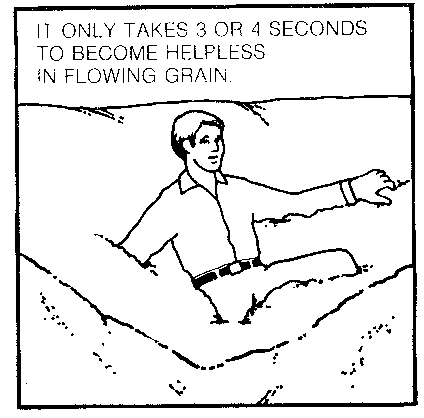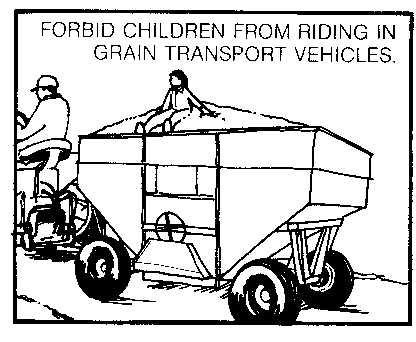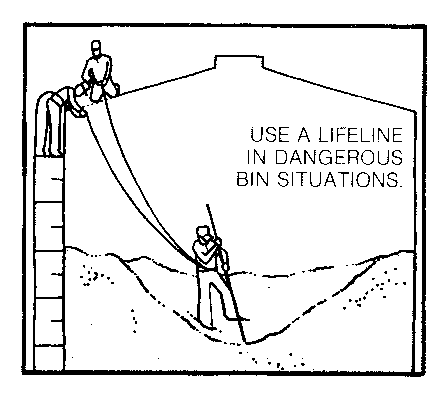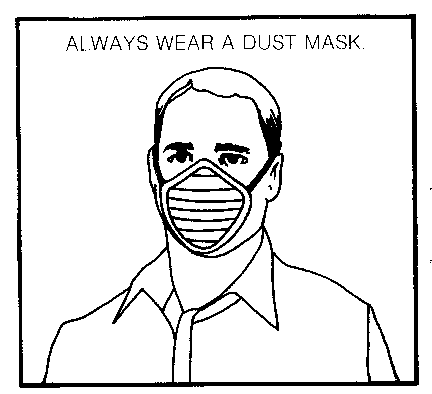
S-77

There has been growing concern during the past few years over the considerable number of entrapments and suffocations taking place in flowing grain. Major causes that have been identified include faster grain handling procedures, larger storage facilities, year-round storage of grain, and a lack of awareness of the great danger in handling flowing grain.
Working with flowing grain is hazardous. An unsuspecting farmer who enters a grain bin with the unloader running may be caught in the grain flow before realizing what has happened. It takes only 4 or 5 seconds for you to submerge to the point where you're helpless. And, it takes less than 20 seconds to be completely submerged in flowing grain.

The hazards in a grain bin are many. These case histories illustrate some of them.
A farmer found the flow to his unloading auger plugged when he started to unload his bin. Working alone, he let the auger run while he poked with a pipe from above. When the pipe broke through the grain caked over the auger intake, he was almost immediately submerged to his waist in the grain. Luckily, the pipe jammed the intake, but he was trapped in the bin until late in the day.
A father and son found an unbroken surface crust in a bin after removing several loads. The son walked across it safely, but the heavier father broke through and plunged into the cavity and flowing grain. He was submerged before his son could stop the equipment.
A grain farmer entered the wet holding bin that feeds his automatic dryer. The dryer started automatically and he was drawn into the wet grain and suffocated.
An elevator worker entered a bin to break up a vertical pile of grain that would not flow. When he dug into the base of the pile, he was covered in an avalanche. He suffocated under only 12 inches of grain. He could not get up, since each square foot of his body was covered by a cubic foot of grain weighing nearly 50 pounds.
Few people realize the hazard from flowing grain You sink in about a foot when walking on dry grain. Grain removal below will almost instantly submerge you over the knees. It takes less than 5 seconds to render you completely helpless.
The flow only needs to remove the volume of your body, 5 to 7 cubic feet, to cover you. This only takes 15 to 20 seconds with an average flow. A child is covered even more quickly.
Numerous entrapments and suffocations have also occurred in high capacity grain transport vehicles. Most cases involve trucks equipped with grain beds or gravity dump wagons in which the victims were riding. Nearly all the victims were young children buried during the loading or unloading of the vehicle.
The potential of an extra rider, especially a child, being buried in a truck or wagon can be readily visualized when considering the rate at which modern combines discharge their grain tanks. A 12-inch auger on a typical 6- to 8-row combine can unload a 200-bushel grain tank in less than 2 minutes.


Suffocation accidents don't have to happen. Follow these safety rules to protect yourself and others:

Even a small amount of spoiled grain can produce millions of tiny mold spores which easily become airborne when disturbed. Airborne mold spores can be inhaled into the lungs through the nose and mouth, irritating sensitive tissue and in some individuals causing reactions so severe that hospitalization is necessary. Farmers working without respiratory protection inside a bin or other grain storage facility in which moldy grain is present are especially vulnerable to mold reactions.
Here are some other safety measures that can help protect you:
A Federal farm labor law affects you. Unless you are working on a farm owned or operated by your parent or guardian, you are restricted from operating or helping to operate (including starting, stopping, adjusting, feeding or any other activity involving physical contact) certain farm machinery, including auger conveyor, feed grinder, crop dryer, forage blower or the unloading mechanism of a non-gravity type self-loading wagon. However, you may perform these jobs at age 14 if you have special training.
Rev 3/90
Cooperative Extension work in Agriculture and Home Economics, state of Indiana, Purdue university, and U.S. Department of Agriculture cooperating; H. A. Wadsworth, Director, West Lafayette, IN. Issued in furtherance of the acts of May 8 and June 30, 1914. The cooperative Extension Service of Purdue university is an affirmative action/equal opportunity institution.